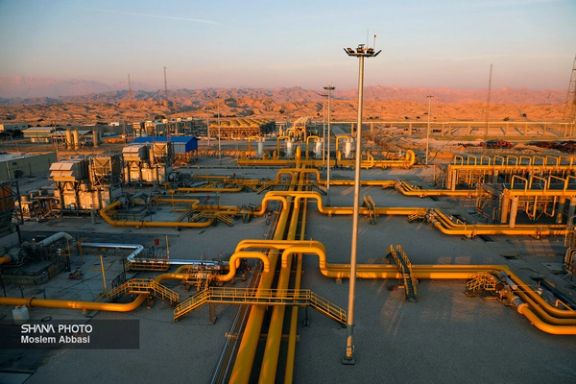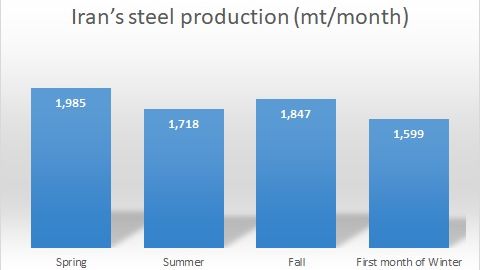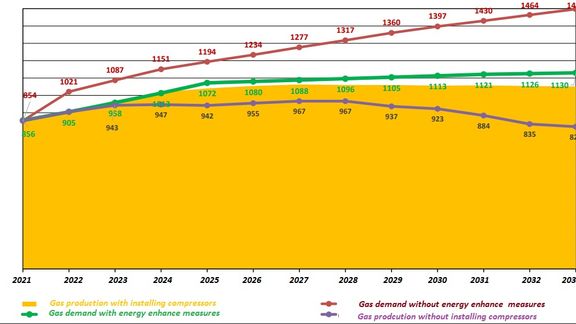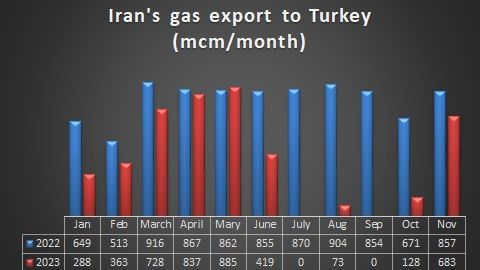Iran Insists On Gas Export, Starving Domestic Industry

Iran’s insistence on gas exports despite the huge deficit in production and growing domestic demand that has severely damaged the country’s industrial sector.

Iran’s insistence on gas exports despite the huge deficit in production and growing domestic demand that has severely damaged the country’s industrial sector.
Plunging electricity deliveries in warm months and gas in the cold season to major industrial sectors, including petrochemicals, cement, and steel, has widened their idle capacity.
The energy value (heat of combustion) of one cubic meter of natural gas is approximately equal to one liter of mazut or diesel. Despite the Iranian government gaining $4.5 billion from gas exports during the last fiscal year, it had to consume an additional 18 billion liters of diesel and mazut domestically, worth over $9 billion.
Amin Ebrahimi, the vice president of the Iran Steel Manufacturers Association, told the ILNA news website in Tehran that the government has cut gas deliveries to this sector by 30 to 50 percent since November 2023. According to him, the country’s nominal iron and steel production capacity is 46 million metric tons per year (mt/yr), but the actual production volume hardly reaches 33 mt/y due to the energy deficit.
Steel exports rank second after petrochemicals in terms of the country’s non-oil export revenues. According to the Iran Steel Manufacturers Association’s statistics, the country’s steel production declined last summer due to electricity deficits and plunged in January 2024 due to severe gas deficits.
The country’s steel products export value also declined by 5.5 percent to $6.2 billion in the first ten months of the current fiscal year, which started on March 22, 2023. Ebrahimi did not elaborate on how much gas is being delivered to the Iranian steel sector now, but according to a report prepared by the National Iranian Gas Company (NIGC) and seen by Iran International, the average gas deliveries to this sector were 39 million cubic meters per day (mcm/d) last spring.
According to Iran Steel Manufacturers Association’s statistics, the country’s steel production has declined in last summer due to electricity deficit and plunged in January 2024 due to severe gas deficit.

Industrial sector’s gas demand
According to another report prepared by National Petrochemical Company, seen by Iran International, the country produced only 69.7 million tons of petrochemicals during last fiscal year, while this sector’s nominal capacity is 91.5 million tons. In other words, about 25 percent of the capacity of petrochemical plants was idle, mostly due to gas shortages.
In a related context, Mehdi Mahdavi Abhari, the Secretary-General of the Petrochemical Employers Association, announced recently that Iran lost $800 million in petrochemical exports due to gas supply shortages last year. The National Gas Company’s report shows about 70 mcm/d of gas was delivered to petrochemicals last spring, but the current volume is unclear.
However, Saeed Aghli, the head of dispatching operations at the NIGC, said last week that the major industrial sectors (petrochemicals, steel, and cement) are supplied with 78 mcm/d of gas. The NIGC’s report, seen by Iran International, indicates that the figure was 150 mcm/d last spring. In simple terms, NIGC has declined gas deliveries to the major industrial sectors by 48% to compensate for gas deficits in housing, public, business, small industries, and agriculture sectors, where the demand rose from 225 mcm/d in spring to 646 mcm/d last week.
Petrochemicals share 7.5% of Iran’s GDP and 25% of its non-oil exports. Another sector severely affected by gas shortages is electricity generation, where 256 mcm/d of gas was utilized last spring, but the volume plunged to 120 mcm/d last week. Iran uses a huge amount of very dirty mazut fuel as well as diesel to compensate for gas shortages in power plants and industrial sectors during winters. Oil ministry statistics show the country’s daily mazut and diesel consumption increased by 115% and 45% to 43,000 metric tons and 110,000 metric tons, respectively, during the last four years due to increasing gas deficits. Iran faces a 250-300 mcm/d gas shortage in winters, but Arash Najafi, the chairman of the Energy Commission of the Iran Chamber of Commerce, said on February 13 that the deficit volume is expected to double in the coming years.
Petrochemicals account for 7.5% of Iran’s GDP and 25% of its non-oil exports.

Gas export
Another sector severely affected by gas shortages is electricity generation, where 256 mcm/d of gas was utilized last spring, but the volume plunged to 120 mcm/d last week. Iran resorts to a significant amount of very dirty mazut fuel as well as diesel to compensate for gas shortages in power plants and industrial sectors during winters. Oil ministry statistics indicate that the country’s daily mazut and diesel consumption increased by 115 percent and 45 percent to 43,000 metric tons and 110,000 metric tons, respectively, during the last four years due to increasing gas deficits. Iran faces a 250-300 mcm/d gas shortage in winters, but Arash Najafi, the chairman of the Energy Commission of the Iran Chamber of Commerce, stated on February 13 that the deficit volume is expected to double in the coming years.
